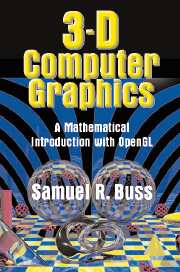Book contents
- Frontmatter
- Contents
- Preface
- I Introduction
- II Transformations and Viewing
- III Lighting, Illumination, and Shading
- IV Averaging and Interpolation
- V Texture Mapping
- VI Color
- VII Bézier Curves
- VIII B-Splines
- IX Ray Tracing
- X Intersection Testing
- XI Radiosity
- XII Animation and Kinematics
- A Mathematics Background
- B RayTrace Software Package
- Bibliography
- Index
- Plate section
III - Lighting, Illumination, and Shading
Published online by Cambridge University Press: 05 June 2012
- Frontmatter
- Contents
- Preface
- I Introduction
- II Transformations and Viewing
- III Lighting, Illumination, and Shading
- IV Averaging and Interpolation
- V Texture Mapping
- VI Color
- VII Bézier Curves
- VIII B-Splines
- IX Ray Tracing
- X Intersection Testing
- XI Radiosity
- XII Animation and Kinematics
- A Mathematics Background
- B RayTrace Software Package
- Bibliography
- Index
- Plate section
Summary
Lighting and shading are important tools for making graphics images appear more realistic and more understandable. Lighting and shading can provide crucial visual cues about the curvature and orientation of surfaces and are important in making three-dimensionality apparent in a graphics image. Indeed, good lighting and shading are probably more important than correct perspective in making a scene understandable.
Lighting and illumination models in computer graphics are based on a modular approach wherein the artist or programmer specifies the positions and properties of light sources, and, independently, specifies the surface properties of materials. The properties of the lights and the materials interact to create the illumination, color, and shading seen from a given viewpoint.
For an example of the importance of lighting and shading for rendering three-dimensional images, refer to Figure III.1. Figure III.1(b) shows a teapot rendered with a solid color with no shading. This flat, featureless teapot is just a silhouette with no three-dimensionality. Figure III.1(c) shows the same teapot but now rendered with the Phong lighting model. This teapot now looks three-dimensional, but the individual polygons are clearly visible. Figure III.1(d) further improves the teapot by using Gouraud interpolation to create a smooth, rounded appearance. Finally, Figures III.1(e) and (f) show the teapot with specular lighting added; the brightly reflecting spot shown in (e) and (f) is called a specular highlight.
- Type
- Chapter
- Information
- 3D Computer GraphicsA Mathematical Introduction with OpenGL, pp. 67 - 98Publisher: Cambridge University PressPrint publication year: 2003



